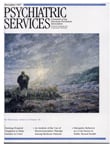To the Editor: Neuroleptic malignant syndrome (NMS) is a serious adverse reaction to neuroleptic drugs. It is characterized by muscle rigidity and elevated temperature with at least two of the following findings: tachycardia, elevated or labile blood pressure, diaphoresis, dysphagia, tremor, incontinence, altered level of consciousness, mutism, leukocytosis, and elevated creatine phosphokinase (CPK) (
1).
The frequency of NMS in patients treated with neuroleptics ranges from .02 to 1.9 percent (
2). We present a case of thioridazine-induced NMS, possibly exacerbated later by the new atypical antipsychotic medication olanzapine.
A 37-year-old African-American man with schizophrenia was hospitalized for possible acute renal failure. Treatment had previously included thioridazine 300 mg per day, and valproic acid 750 mg per day. At entry into the hospital the patient had a fever of 101 degrees F, hypertension (166/95 mm Hg), and altered mental status with prominent confusion. Rigidity was found on physical examination. Laboratory studies revealed elevated levels of blood urea nitrogen (BUN) (43 mg/dL), creatinine (2.6 mg/dL), sodium (155 mmol/L), and CPK (3294 U/L). The patient was dehydrated.
Neuroleptic malignant syndrome was the primary diagnosis. Thioridazine and valproic acid were discontinued. Seven days later, after hydration, the patient was physiologically stable and was transferred to the psychiatric service with no sign of NMS. Rigidity had disappeared. Laboratory results showed normal levels of BUN at 12 mg/dL, creatinine at 1.2 mg/dL, sodium at 142 mmol/L, and CPK at 174 U/L. A mental status examination evidenced only psychosis.
The morning after the patient's transfer, olanzapine 5 mg per day was prescribed because of its relative lack of association with NMS. On the second day in the psychiatric unit, as a result of newly documented hypertension (148/94 mm Hg), the olanzapine dosage was decreased to 2.5 mg per day. The patient's blood pressure then stabilized, and olanzapine was titrated over a three-day period up to 7.5 mg daily. On the fifth day after beginning olanzapine treatment, he became tachycardic (pulse, 114), hypertensive (blood pressure,139/90 mm Hg), and diaphoretic. His temperature remained normal. Serum CPK increased to 704 and BUN and creatinine levels again became elevated slightly to 28 mg/dL and 1.5 mg/dL, respectively.
Olanzapine was discontinued, and the patient recovered the following day, with normal vital signs. Because he was clinically improved but still psychotic, olanzapine was then restarted at 2.5 mg and more slowly titrated to 5 mg daily over five days with monitoring of vital signs, physical observations, and serum chemistries. No further complications occurred, and the psychosis diminished. The patient was discharged on olanzapine 5 mg per day with improved mental status, without NMS, well hydrated, and with a blood chemistry profile within normal ranges.
The patient's initial hospitalization was precipitated by neuroleptic malignant syndrome induced by thioridazine and complicated by dehydration. One week later, after the resolution of NMS and pre-renal azotemia, olanzapine was prescribed to treat the patient's psychosis because of the drug's relatively low affinity for dopamine D
2 striatal receptors and its low risk for causing NMS (
3). However, administration of olanzapine at a 7.5 mg dose re-created a clinical picture compatible with very early NMS. By beginning olanzapine one week after recovery from NMS, the patient may have been at a higher risk for its return.
On the second olanzapine trial, at two weeks post-NMS and with a more slowly escalating dosage, the patient was stabilized on 5 mg per day without evidence of NMS. Good hydration, the lower dosage, and the longer wait after recovery from NMS may have provided additional safety. An antipsychotic response occurred without problems.
Whether olanzapine could result in NMS or similar adverse side effects remains an unanswered question. Caution, close observation, and hydration are warranted whenever antipsychotic pharmaceuticals, including olanzapine, are given to people at risk for NMS.

